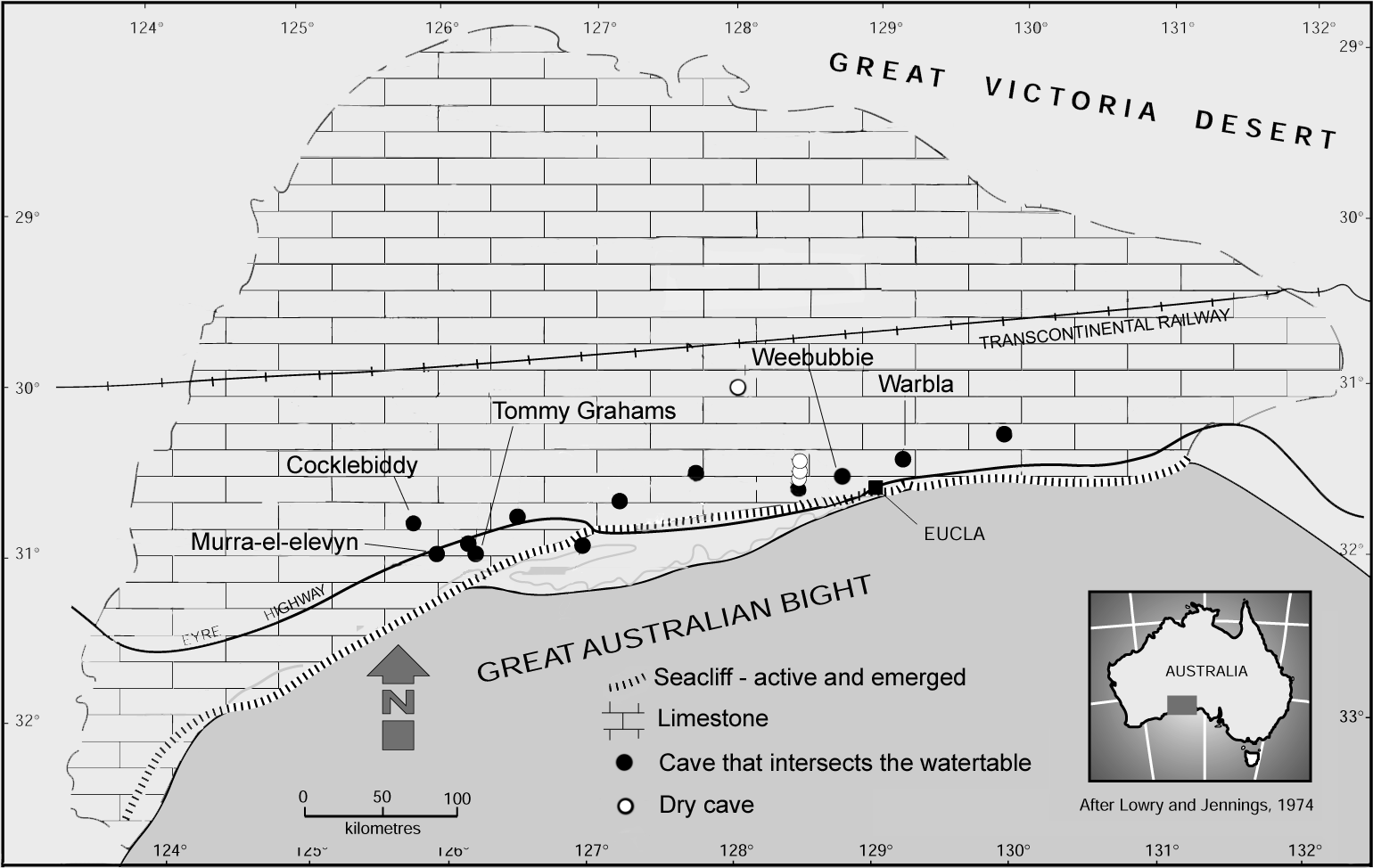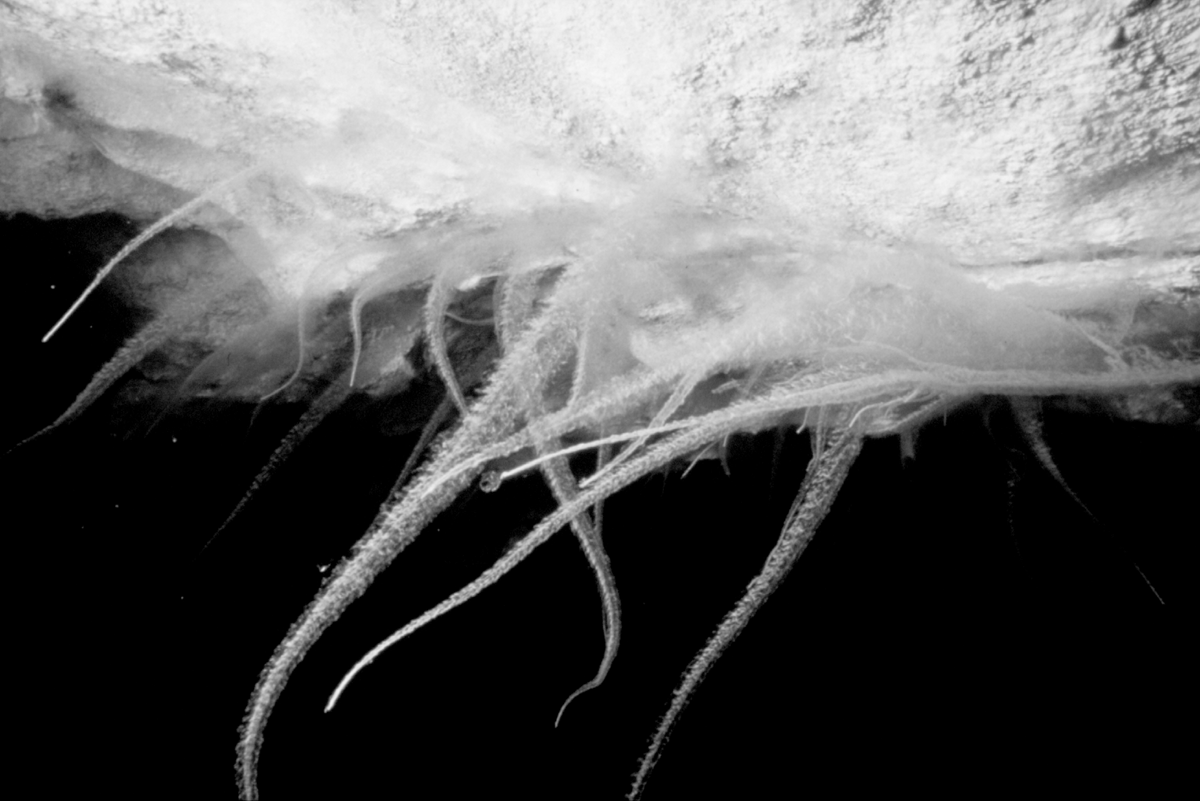Challenges in conservation of the microbial mantles in Nullarbor Caves
The Nullarbor region of Australia is the worlds largest contiguous karst system (Figure 1), with an area in excess of 200 000 km2. The area is an unbroken plateau of horizontal Eocene and Miocene limestones. The Bunda Plateau, 240 m above sea level in its northwestern part, declines gently and almost uniformly southwards and eastwards to end against the sea in the Bunda Cliffs on the east, 40 to 70 m high, and in the Baxter cliffs on the west, 60 to 90 m high (Lowry and Jennings 1974). The climate is arid to semi-arid with rainfall between 150 mm – 200 mm a–1 (Gillieson and Spate 1992).
A number of extensive caves have been discovered in the area, including the largest chamber and longest underwater passage in Australia. The entrance to these caves is typically through dolines, formed as the result of collapse of a portion of the cave roof. A number of caves in this area intersect the Nullarbor aquifer, an extensive saline groundwater body that forms a watertable up to 100m below the surface.
Some recent studies have focussed on the microbial mantles (also know as the fungus or snotites) found in many of the flooded passages in the caves. These mantles comprise sheets or tongues of mucoid material in which small crystals are embedded. The biomass is primarily composed of densely packed, unbranched filaments, together with spherical, rod and spiral shaped cells, and microcrystals of calcite in a mucoid matrix.
Molecular techniques have been used to analyse the DNA of the organisms making up these mantles. By examining differences in the 16s RNA sequence the relationship of the organisms within the community can be compared to known organsisms. The results were startling.

The community appears to be chemautotrophic. The energy source for the community appears to be based on the oxidation of nitrite to nitrate rather than on photosynthetic products. Chemotrophic systems are rare but not unheard of, including deep sea vents and sulfur based cave systems such as Moville Cave Romania and Cueva de Villa Luz Mexico .
36 different organisms could be identified using the molecular techniques. The different organisms within the community show a great diversity. There are 12 organisms that could not be identified at the subdivision level making them significantly different from all other catalogued organisms. (Holmes et al 2001)
Above the microbial mantles the rock appears to be etch or pitted to depths of 3-5mm, indicating the microbial community may be playing a role in speleogenesis.
The mantles are fragile and easily disturbed by divers air bubbles and currents. During the early stages of diving under the Nullarbor, divers reported mantles up to 1m long in the main passages. These are no longer observed, instead the mantles are only found in undisturbed areas.
Given how little we know about the community (including their ability to regenerate after being disturbed), it is important to consider their preservation.
The clarity of the water and the size of the passages makes the Nullarbor caves a popular destination for cave divers. Diving poses two potential threats to the community, disruption of their growth and through the introduction of competing bacteria.
Diving has resulted in the disappearance of the mantles in the major passageways. Divers disturb mantles growing on the roofs and walls of the passages by creating currents and air bubbles. Mantles can still be observed on walls and in small crevices.
The second potential impact the divers can have is the introduction of competing bacteria into this otherwise isolated system. There are many cases where organisms have been introduced into a pristine environment and subsequently out competed the native organisms. The cave waters may be suitable for marine bacteria that hitch a ride on a wetsuit. From divers descriptions and the DNA analysis it appears that this has not occurred yet, but is is still a possibility that should not be ignored.
Protecting the communities poses interesting challenges particularly as the area is remote and the cave entrances large.
Possibilities for Protecting
Closing all caves
Closing all the caves is unlikely to prevent people from accessing the caves. Instead it is likely to put the cave manager at loggerheads with the cavers. The caves are a long way from the managing authorities, which makes policing entry difficult. The large boulderpile entrances are very difficult to gate, which means the most likely outcome from a closed cave policy would be unauthorised trips. In being unable to monitor the affects of diving in the cave, it will make preservation of the mantles more difficult.
Permit System
A permit system currently operates for land managed by the Department of Land Administration (DOLA) and the Deparment of Conservation and Land Management, Western Australia. Permits are readily available to suitably qualified divers. A permit system is also run by National Parks and Wildlife Services South Australia that provides access for caving projects.
A readily accessible permit system means it is easy to keep records of visitation levels and unauthorised trips are unlikely. A permit system that provides ready access to the caves is recommended as a part of the cave management plan.
No-Go Areas
In conjunction with experience divers, we recommend designating some areas of the cave no-go areas. This will allow the mantles to grow undisturbed and allow for assessment of their growth and regeneration rates.
Diver Education
It is important to inform the divers, through journals such as CDAA's Guidelines and Australian Caver of the significance of the mantles and the impacts that their diving has on the community.
Interpretive Signs at the Dive sites
As well as the current "cave risk area" signs we recommend a sign for the divers to outline the steps they can take to minimise the damage to the mantles, including cautious swimming near the walls, respecting the no-go areas and the risk of introducing foreign bacteria through their wetsuits.
Conclusions
The microbial mantles of the Nullarbor Caves are a unique and poorly studied ecosystem at risk of damage through diving. To protect the mantles, we recommend continuation of the current permit system and the designation of no-go areas so the communities can be protected for further investigation. This should be coupled with diver education such as articles in the cave diving journals and interpretive signs for the divers.

References
GILLIESON D. and SPATE A. (1992) The Nullarbor Karst. In D. GILLIESON (ed), Geology, climate, hydrology and karst formation: field symposium in Australia guidebook. Special Publication No. 4, pp. 65-99. Department of Geography and Oceanography, University College, Australia Defence Force Academy.
HOLMES, A. J., TUJULA, N. A. HOLLEY, M., CONTOS, A. K., JAMES, J. M. ROGERS, P.and GILLINGS, M. R., (2001) Phylogenetic Structure of Unusual Aquatic Microbial Formations in Nullarbor Caves, Australia. Environ Microbiol, forthcoming
HOSE L. D., PALMER A. N., PALMER M. V., NORTHUP D. E., BOSTON P. J., and DUCHENE H. R. (2000) Microbiology and geochemistry in a hydrogen-sulphide rich karst environment. Chem Geol 169(3-4): 399-423.
HOSE L. D. and PISAROWICZ J. A. (1999) Cueva de Villa Luz, Tabasco, Mexico: Reconnaissance study of an active sulfur spring cave and ecosystem. Journal of Cave and Karst Studies 61(1): 13-21.
LOWRY D. C. and JENNINGS J. N. (1974) The Nullarbor Karst Australia. Z Geomorphol 18(1): 35-81.
SARBU S. M. (2000) Movile Cave. In Subterranean Ecosystems, Vol. 30 (ed. H. Wilkens, D. C. Culver, and W. F. Humphreys), pp. 319-343. Elsevier.
SARBU S. M. and KANE T. C. (1995) A subterranean chemoautotrophically based ecosystem. NSS Bull 57(2): 91-98.
SARBU S. M., KANE T. C., and KINKLE B. M. (1996) A chemoautotrophically based cave ecosystem. Science 272(5270): 1953.